同济大学:《当代中国》课程教学资源(PPT讲稿)Basic information on SWM
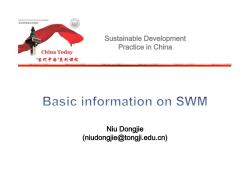
eneral Courses Given in English 英语讲授通识类课程 Sustainable Development Practice in China China Today "当代中国"系列课程 Basic information on SWM Niu Dongjie (niudongjie@tongji.edu.cn)
Niu Dongjie (niudongjie@tongji.edu.cn) Sustainable Development Practice in China

Table of Contents What are wastes and ISWMS? ·Landfilling ·Incineration 。Composting 。Anaerobic digestion
Table of Contents • What are wastes and ISWMS? • Landfilling • Incineration • Composting • Anaerobic digestion

What are Wastes? Comprises all the wastes arising from human and animal activities that are normally solid and that are discarded as useless or unwanted. Basel Convention Definition of Wastes "substances or objects which are disposed of or are intended to be disposed of or are required to be disposed of by the provisions of the law Disposal means "any operation which may lead to resource recovery,recycling, reclamation,direct re-use or alternative uses(Annex IVB of the Basel convention) 3
3 What are Wastes? Comprises all the wastes arising from human and animal activities that are normally solid and that are discarded as useless or unwanted. Basel Convention Definition of Wastes “substances or objects which are disposed of or are intended to be disposed of or are required to be disposed of by the provisions of the law” Disposal means “any operation which may lead to resource recovery, recycling, reclamation, direct re‐use or alternative uses (Annex IVB of the Basel convention)
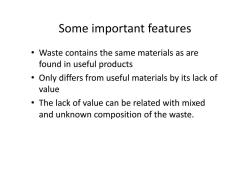
Some important features Waste contains the same materials as are found in useful products Only differs from useful materials by its lack of value The lack of value can be related with mixed and unknown composition of the waste
Some important features • Waste contains the same materials as are found in useful products • Only differs from useful materials by its lack of value • The lack of value can be related with mixed and unknown composition of the waste
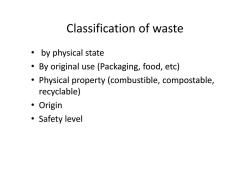
Classification of waste ·by physical state By original use(Packaging,food,etc) Physical property (combustible,compostable, recyclable) 。Origin 。Safety level
Classification of waste • by physical state • By original use (Packaging, food, etc) • Physical property (combustible, compostable, recyclable) • Origin • Safety level
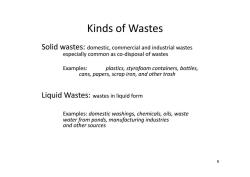
Kinds of Wastes Solid wastes:domestic,commercial and industrial wastes especially common as co-disposal of wastes Examples:plastics,styrofoam containers,bottles, cans,papers,scrap iron,and other trash Liquid Wastes:wastes in liquid form Examples:domestic washings,chemicals,oils,waste water from ponds,manufacturing industries and other sources 6
6 Kinds of Wastes Solid wastes: domestic, commercial and industrial wastes especially common as co‐disposal of wastes Examples: plastics, styrofoam containers, bottles, cans, papers, scrap iron, and other trash Liquid Wastes: wastes in liquid form Examples: domestic washings, chemicals, oils, waste water from ponds, manufacturing industries and other sources
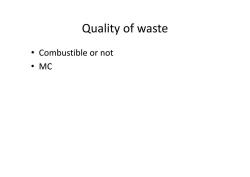
Quality of waste ·Combustible or not ·MC
Quality of waste • Combustible or not • MC
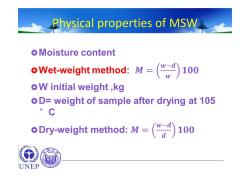
Physical properties of MSW o Moisture content Wet-weight method:M=100 oW initial weight kg oD=weight of sample after drying at 105 。C Dry-weight method:M=100 UNEP
Physical properties of MSW
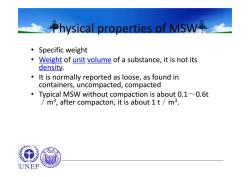
Physical properties of MSW Specific weight 。 Weight of unit volume of a substance,it is not its density. It is normally reported as loose,as found in containers,uncompacted,compacted Typical MSW without compaction is about 0.1~0.6t /m3,after compacton,it is about 1 t m3. 90 UNEP
Physical properties of MSW • Specific weight • Weight of unit volume of a substance, it is not its density. • It is normally reported as loose, as found in containers, uncompacted, compacted • Typical MSW without compaction is about 0.1~0.6t /m3, after compacton, it is about 1 t/m3
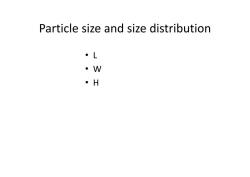
Particle size and size distribution 。L ·W 。H
Particle size and size distribution • L • W • H
按次数下载不扣除下载券;
注册用户24小时内重复下载只扣除一次;
顺序:VIP每日次数-->可用次数-->下载券;
- 《南京政治学院学报》:北极安全新态势与中国北极安全利益维护(中国海洋大学:孙凯、吴昊).pdf
- 《中国海商法研究》:构建海洋命运共同体与维护海洋安全的辩证思考及实现路径(上海国际问题研究院:张琪悦).pdf
- 国家开放大学:2016年秋季学期“开放专科”农村经济管理专业农村环境保护期末试题(1月).pdf
- 国家开放大学:2016年春季学期“开放本科”社会工作专业人类成长与社会环境期末试题(半开卷).pdf
- 国家开放大学:2016年春季学期“开放专科”农村行政管理专业农村环境保护期末试题(7月).pdf
- 国家开放大学:2016年春季学期“开放专科”农村经济管理专业农村环境保护期末试题(7月).pdf
- 国家开放大学:2015年秋季学期“开放本科”社会工作专业人类成长与社会环境期末试题(半开卷).pdf
- 国家开放大学:2015年秋季学期“开放专科”农村经济管理专业农村环境保护期末试题(1月).pdf
- 国家开放大学:2015年春季学期“开放本科”社会工作专业人类成长与社会环境期末试题(半开卷).pdf
- 国家开放大学:2015年春季学期“开放专科”农村经济管理专业农村环境保护期末试题(7月).pdf
- 国家开放大学:2014年秋季学期“开放本科”社会工作专业人类成长与社会环境期末试题(半开卷).pdf
- 国家开放大学:2014年秋季学期“开放专科”农村经济管理专业农村环境保护期末试题(1月).pdf
- 国家开放大学:2013—2014学年第二学期“开放本科”社会工作专业人类成长与社会环境期末试题(半开卷).pdf
- 国家开放大学:2013—2014学年第二学期“开放专科”农村经济管理专业农村环境保护期末试题(7月).pdf
- 国家开放大学:2013—2014学年第一学期“开放本科”社会工作专业人类成长与社会环境期末试题(半开卷).pdf
- 国家开放大学:2013—2014学年第一学期“开放专科”农村经济管理专业农村环境保护期末试题(1月).pdf
- 国家开放大学:2012—2013学年第二学期“开放本科”社会工作专业人类成长与社会环境期末试题(半开卷).pdf
- 国家开放大学:2012—2013学年第二学期“开放专科”农村经济管理专业农村环境保护期末试题(7月).pdf
- 国家开放大学:2012—2013学年第一学期“开放本科”社会工作专业人类成长与社会环境期末试题(半开卷).pdf
- 国家开放大学:2012—2013学年第一学期“开放专科”农村经济管理专业农村环境保护期末试题(1月).pdf
- 同济大学:《当代中国》课程教学资源(PPT讲稿)SWM in China before and after Agenda 21.pdf
- 广东海洋大学:环境资源系《旅游法规概论》课程教学大纲.doc
- 广东海洋大学:环境资源系《保护生物学学》课程教学大纲.doc
- 广东海洋大学:环境资源系《园艺专业测量学》课程教学大纲.doc
- 广东海洋大学:环境资源系《旅游市场学》课程教学大纲.doc
- 广东海洋大学:环境资源系《旅游文化学》课程教学大纲.doc
- 广东海洋大学:环境资源系《旅游英语》课程教学大纲.doc
- 广东海洋大学:环境资源系《景观地理学》课程教学大纲.doc
- 广东海洋大学:环境资源系《景观生态学》课程教学大纲.doc
- 广东海洋大学:环境资源系《林资等专业生物统计学》课程教学大纲.doc
- 广东海洋大学:环境资源系《树木学》课程教学大纲.doc
- 广东海洋大学:环境资源系《森林旅游学》课程教学大纲.doc
- 广东海洋大学:环境资源系《森林环境学》课程教学大纲.doc
- 广东海洋大学:环境资源系《环境保护学》课程教学大纲.doc
- 广东海洋大学:环境资源系《生态旅游学》课程教学大纲.doc
- 广东海洋大学:环境资源系《自然保护区管理学》课程教学大纲.doc
- 广东海洋大学:环境资源系《遥感与地理信息系统》课程教学大纲.doc
- 广东海洋大学:环境资源系《饭店管理学》课程教学大纲.doc
- 广东海洋大学:环境资源系《旅游学》课程教学大纲.doc
- 广东海洋大学:环境资源系《旅游心理学》课程教学大纲.doc
